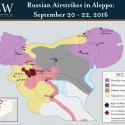 |
 |
Russian Airstrikes in Aleppo Province: September 20 - 22, 2016

Russia intensified its air campaign against the Syrian opposition in and around Aleppo City from September 20 – 22 following the breakdown of the nationwide ceasefire in Syria. The dramatic uptick in Russian airstrikes coincided with the Syrian Arab Army’s announcement of the start of an offensive to seize the remaining opposition-held districts of Aleppo City on September 22, demonstrating Russia’s continued commitment to support pro-regime operations against the Syrian opposition. Russian strikes concentrated against opposition-held terrain in the southern districts of Aleppo City as well as in the city’s western countryside, marking the largest three-day surge in Russian airstrikes against the city and its environs since mid-August. Russian warplanes reportedly conducted several airstrikes using cluster or incendiary munitions, including an alleged wave of incendiary attacks against opposition frontlines south of Aleppo City, while regime jets also intensified their bombardment of the city and its suburbs. The surge in Russian strikes defied U.S. Secretary of State John Kerry’s demand on September 21 that pro-regime forces “immediately ground all aircraft” flying over opposition-held areas in order to “restore credibility” to U.S.-Russian negotiations on the Syrian Civil War. Russia has periodically intensified and tempered its air operations in Aleppo Province during negotiations with the U.S., wielding the threat of even deeper humanitarian crisis and the defeat of the acceptable opposition in Aleppo City in order to extract concessions. Russia will not accede to a partnership with the U.S. except on its own terms, and will continue to wage its air campaign in Syria coercively in order to secure them.